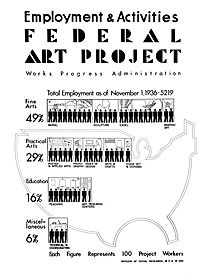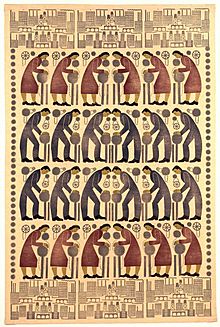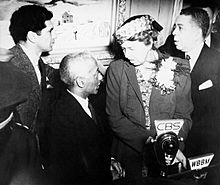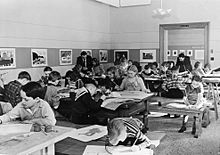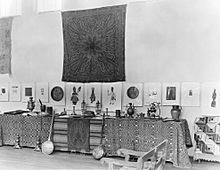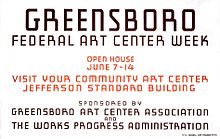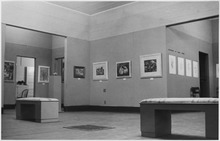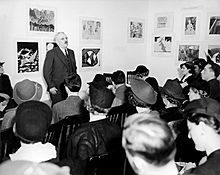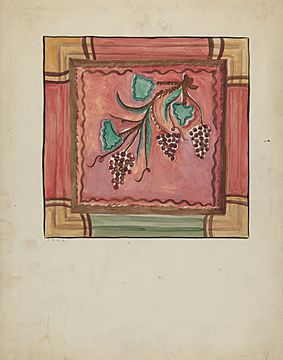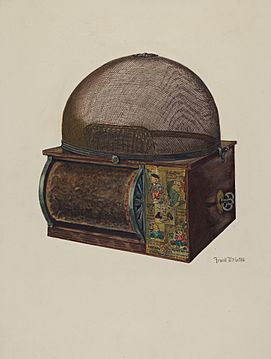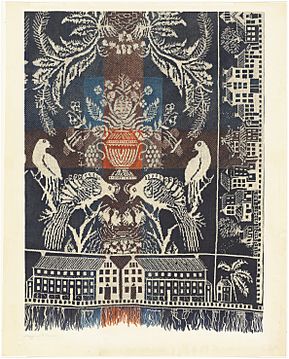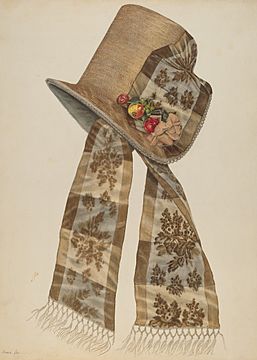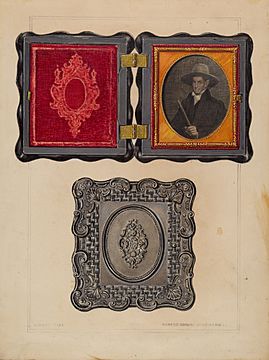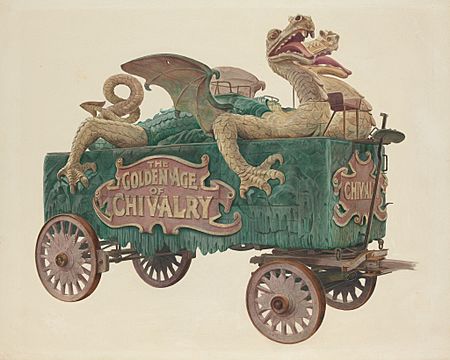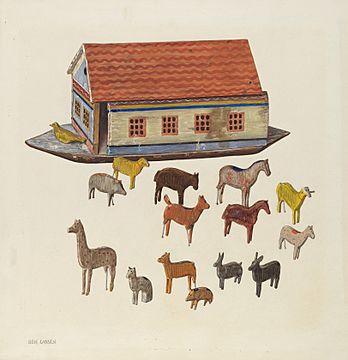Federal Art Project facts for kids
Eagle and palette design regarded as the logo of the Federal Art Project
|
|
| Agency overview | |
|---|---|
| Formed | 29 August 1935 |
| Dissolved | 1943 |
| Jurisdiction | United States |
| Headquarters | Washington, D.C. |
| Agency executive |
|
| Parent department | Works Progress Administration (WPA) |
The Federal Art Project (1935–1943) was a New Deal program to fund the visual arts in the United States. Under national director Holger Cahill, it was one of five Federal Project Number One projects sponsored by the Works Progress Administration (WPA), and the largest of the New Deal art projects. It was created not as a cultural activity, but as a relief measure to employ artists and artisans to create murals, easel paintings, sculpture, graphic art, posters, photography, theatre scenic design, and arts and crafts. The WPA Federal Art Project established more than 100 community art centers throughout the country, researched and documented American design, commissioned a significant body of public art without restriction to content or subject matter, and sustained some 10,000 artists and craft workers during the Great Depression.
Contents
Background
The Federal Art Project was the visual arts arm of Federal Project Number One, a program of the Works Progress Administration, which was intended to provide employment for struggling artists during the Great Depression. Funded under the Emergency Relief Appropriation Act of 1935, it operated from August 29, 1935, until June 30, 1943. It was created as a relief measure to employ artists and artisans to create murals, easel paintings, sculpture, graphic art, posters, photographs, Index of American Design documentation, museum and theatre scenic design, and arts and crafts. The Federal Art Project operated community art centers throughout the country where craft workers and artists worked, exhibited, and educated others. The project created more than 200,000 separate works, some of them remaining among the most significant pieces of public art in the country.
The Federal Art Project's primary goals were to employ out-of-work artists and to provide art for nonfederal municipal buildings and public spaces. Artists were paid $23.60 a week; tax-supported institutions such as schools, hospitals, and public buildings paid only for materials. The work was divided into art production, art instruction, and art research. The primary output of the art-research group was the Index of American Design, a mammoth and comprehensive study of American material culture.
As many as 10,000 artists were commissioned to produce work for the WPA Federal Art Project, the largest of the New Deal art projects. Three comparable but distinctly separate New Deal art projects were administered by the United States Department of the Treasury: the Public Works of Art Project (1933–1934), the Section of Painting and Sculpture (1934–1943), and the Treasury Relief Art Project (1935–1938).
The WPA program made no distinction between representational and nonrepresentational art. Abstraction had not yet gained favor in the 1930s and 1940s, so was virtually unsalable. As a result, the Federal Art Project supported such iconic artists as Jackson Pollock before their work could earn them income.
One particular success was the Milwaukee Handicraft Project, which started in 1935 as an experiment that employed 900 people who were classified as unemployable due to their age or disability. The project came to employ about 5,000 unskilled workers, many of them women and the long-term unemployed. Historian John Gurda observed that the city's unemployment hovered at 40% in 1933. "In that year," he said, "53 percent of Milwaukee's property taxes went unpaid because people just could not afford to make the tax payments." Workers were taught bookbinding, block printing, and design, which they used to create handmade art books and children's books. They produced toys, dolls, theatre costumes, quilts, rugs, draperies, wall hangings, and furniture that were purchased by schools, hospitals, and municipal organizations for the cost of materials only. In 2014, when the Museum of Wisconsin Art mounted an exhibition of items created by the Milwaukee Handicraft Project, furniture from it was still being used at the Milwaukee Public Library.
Holger Cahill was national director of the Federal Art Project. Other administrators included Audrey McMahon, director of the New York Region (New York, New Jersey, and Philadelphia); Clement B. Haupers, director for Minnesota; George Godfrey Thorp (Illinois), and Robert Bruce Inverarity, director for Washington. Regional New York supervisors of the Federal Art Project have included sculptor William Ehrich (1897–1960) of the Buffalo Unit (1938–1939), project director of the Buffalo Zoo expansion.
Notable artists
Some 10,000 artists were commissioned to work for the Federal Art Project. Notable artists include the following:
- William Abbenseth
- Berenice Abbott
- Ida York Abelman
- Gertrude Abercrombie
- Benjamin Abramowitz
- Abe Ajay
- Ivan Albright
- Maxine Albro
- Charles Alston
- Harold Ambellan
- Luis Arenal
- Bruce Ariss
- Victor Arnautoff
- Sheva Ausubel
- Jozef Bakos
- Henry Bannarn
- Belle Baranceanu
- Patrociño Barela
- Will Barnet
- Richmond Barthé
- Herbert Bayer
- William Baziotes
- Lester Beall
- Harrison Begay
- Daisy Maud Bellis
- Rainey Bennett
- Aaron Berkman
- Leon Bibel
- Robert Blackburn
- Arnold Blanch
- Lucile Blanch
- Lucienne Bloch
- Aaron Bohrod
- Ilya Bolotowsky
- Adele Brandeis
- Louise Brann
- Edgar Britton
- Manuel Bromberg
- James Brooks
- Selma Burke
- Letterio Calapai
- Samuel Cashwan
- Giorgio Cavallon
- Daniel Celentano
- Dane Chanase
- Fay Chong
- Claude Clark
- Max Arthur Cohn
- Eldzier Cortor
- Arthur Covey
- Alfred D. Crimi
- Francis Criss
- Allan Crite
- Robert Cronbach
- John Steuart Curry
- Philip Campbell Curtis
- James Daugherty
- Stuart Davis
- Adolf Dehn
- Willem de Kooning
- Burgoyne Diller
- Isami Doi
- Mabel Dwight
- Ruth Egri
- Fritz Eichenberg
- Jacob Elshin
- George Pearse Ennis
- Angna Enters
- Philip Evergood
- Louis Ferstadt
- Alexander Finta
- Joseph Fleck
- Seymour Fogel
- Lily Furedi
- Todros Geller
- Aaron Gelman
- Eugenie Gershoy
- Enrico Glicenstein
- Vincent Glinsky
- Bertram Goodman
- Arshile Gorky
- Harry Gottlieb
- Blanche Grambs
- Morris Graves
- Balcomb Greene
- Marion Greenwood
- Waylande Gregory
- Philip Guston
- Irving Guyer
- Abraham Harriton
- Marsden Hartley
- Knute Heldner
- August Henkel
- Ralf Henricksen
- Magnus Colcord Heurlin
- Hilaire Hiler
- Louis Hirshman
- Donal Hord
- Axel Horn
- Milton Horn
- Allan Houser
- Eitaro Ishigaki
- Edwin Boyd Johnson
- Sargent Claude Johnson
- Tom Loftin Johnson
- William H. Johnson
- Leonard D. Jungwirth
- Reuben Kadish
- Sheffield Kagy
- Jacob Kainen
- David Karfunkle
- Leon Kelly
- Paul Kelpe
- Troy Kinney
- Georgina Klitgaard
- Gene Kloss
- Karl Knaths
- Edwin B. Knutesen
- Lee Krasner
- Kalman Kubinyi
- Yasuo Kuniyoshi
- Jacob Lawrence
- Edward Laning
- Michael Lantz
- Blanche Lazzell
- Tom Lea
- Lawrence Lebduska
- Joseph LeBoit
- William Robinson Leigh
- Julian E. Levi
- Jack Levine
- Monty Lewis
- Elba Lightfoot
- Abraham Lishinsky
- Michael Loew
- Thomas Gaetano LoMedico
- Louis Lozowick
- Nan Lurie
- Guy Maccoy
- Stanton Macdonald-Wright
- George McNeil
- Moissaye Marans
- David Margolis
- Kyra Markham
- Jack Markow
- Mercedes Matter
- Jan Matulka
- Dina Melicov
- Hugh Mesibov
- Katherine Milhous
- Jo Mora
- Helmuth Naumer
- Louise Nevelson
- James Michael Newell
- Spencer Baird Nichols
- Elizabeth Olds
- John Opper
- William C. Palmer
- Phillip Pavia
- Irene Rice Pereira
- Jackson Pollock
- George Post
- Gregorio Prestopino
- Mac Raboy
- Anton Refregier
- Ad Reinhardt
- Misha Reznikoff
- Mischa Richter
- Diego Rivera
- José de Rivera
- Emanuel Glicen Romano
- Mark Rothko
- Alexander Rummler
- Augusta Savage
- Concetta Scaravaglione
- Louis Schanker
- Edwin Scheier
- Mary Scheier
- Carl Schmitt
- William S. Schwartz
- Georgette Seabrooke
- Ben Shahn
- William Howard Shuster
- Mitchell Siporin
- John French Sloan
- Joseph Solman
- William Sommer
- Isaac Soyer
- Moses Soyer
- Raphael Soyer
- Ralph Stackpole
- Cesare Stea
- Walter Steinhart
- Joseph Stella
- Harry Sternberg
- Sakari Suzuki
- Albert Swinden
- Rufino Tamayo
- Elizabeth Terrell
- Lenore Thomas
- Dox Thrash
- Mark Tobey
- Harry Everett Townsend
- Edward Buk Ulreich
- Charles Umlauf
- Jacques Van Aalten
- Stuyvesant Van Veen
- Herman Volz
- Mark Voris
- John Augustus Walker
- Andrew Winter
- Jean Xceron
- Edgar Yaeger
- Bernard Zakheim
- Karl Zerbe
Community Art Center program
The first federally sponsored community art center opened in December 1936 in Raleigh, North Carolina.
| State | City | Name | Notes |
|---|---|---|---|
| Alabama | Birmingham | Extension art gallery | |
| Alabama | Birmingham | Healey School Art Gallery | |
| Alabama | Mobile | Mobile Art Center, Public Library Building | |
| Arizona | Phoenix | Phoenix Art Center | |
| District of Columbia | Washington, D.C. | Children's Art Gallery | |
| Florida | Bradenton | Bradenton Art Center | |
| Florida | Coral Gables | Coral Gables Art Gallery | Extension art gallery |
| Florida | Daytona Beach | Daytona Beach Art Center | |
| Florida | Jacksonville | Jacksonville Art Center | |
| Florida | Jacksonville | Jacksonville Beach Art Gallery | Extension art gallery |
| Florida | Jacksonville | Jacksonville Negro Art Center | Extension art gallery |
| Florida | Key West | Key West Community Art Center | |
| Florida | Miami | Miami Art Center | |
| Florida | Milton | Milton Art Gallery | Extension art gallery |
| Florida | New Smyrna Beach | New Smyrna Beach Art Center | |
| Florida | Ocala | Ocala Art Center | |
| Florida | Pensacola | Pensacola Art Center | |
| Florida | St. Petersburg | Jordan Park Negro Exhibition Center | |
| Florida | St. Petersburg | St. Petersburg Art Center | |
| Florida | St. Petersburg | St. Petersburg Civic Exhibition Center | |
| Florida | Tampa | Tampa Art Center | |
| Florida | Tampa | West Tampa Negro Art Gallery | |
| Illinois | Chicago | Hyde Park Art Center | |
| Illinois | Chicago | South Side Community Art Center | |
| Iowa | Mason City | Mason City Art Center | |
| Iowa | Ottumwa | Ottumwa Art Center | |
| Iowa | Sioux City | Sioux City Art Center | |
| Kansas | Topeka | Topeka Art Center | |
| Minnesota | Minneapolis | Walker Art Center | |
| Mississippi | Greenville | Delta Art Center | |
| Mississippi | Oxford | Oxford Art Center | |
| Mississippi | Sunflower | Sunflower County Art Center | |
| Missouri | St. Louis | The People's Art Center | |
| Montana | Butte | Butte Art Center | |
| Montana | Great Falls | Great Falls Art Center | |
| New Mexico | Gallup | Gallup Art Center | |
| New Mexico | Melrose | Melrose Art Center | |
| New Mexico | Roswell | Roswell Museum and Art Center | |
| New York City | Brooklyn | Brooklyn Community Art Center | |
| New York City | Manhattan | Contemporary Art Center | |
| New York City | Harlem | Harlem Community Art Center | |
| New York City | Flushing, Queens | Queensboro Community Art Center | |
| North Carolina | Cary | Cary Gallery | Extension art gallery |
| North Carolina | Greensboro | Greensboro Art Center | |
| North Carolina | Greenville | Greenville Art Gallery | |
| North Carolina | Raleigh | Crosby-Garfield School | Extension art gallery |
| North Carolina | Raleigh | Needham B. Broughton High School | Extension art gallery |
| North Carolina | Raleigh | Raleigh Art Center | |
| North Carolina | Wilmington | Wilmington Art Center | |
| Oklahoma | Bristow | Bristow Art Gallery | Extension art gallery |
| Oklahoma | Claremore | Claremore Art Gallery | Extension art gallery |
| Oklahoma | Claremore | Will Rogers Public Library | Extension art gallery |
| Oklahoma | Clinton | Clinton Art Gallery | Extension art gallery |
| Oklahoma | Cushing | Cushing Art Gallery | Extension art gallery |
| Oklahoma | Edmond | Edmond Art Gallery | Extension art gallery |
| Oklahoma | Marlow | Marlow Art Gallery | Extension art gallery |
| Oklahoma | Oklahoma City | Oklahoma Art Center | |
| Oklahoma | Okmulgee | Okmulgee Art Center | Extension art gallery |
| Oklahoma | Sapulpa | Sapulpa Art Gallery | Extension art gallery |
| Oklahoma | Shawnee | Shawnee Art Gallery | Extension art gallery |
| Oklahoma | Skiatook | Skiatook Art Gallery | Extension art gallery |
| Oregon | Gold Beach | Curry County Art Center | |
| Oregon | La Grande | Grande Ronde Valley Art Center | |
| Oregon | Salem | Salem Art Center | |
| Pennsylvania | Somerset | Somerset Art Center | |
| Tennessee | Chattanooga | Hamilton County Art Center | |
| Tennessee | Memphis | LeMoyne Art Center | |
| Tennessee | Nashville | Peabody Art Center | |
| Tennessee | Norris | Anderson County Art Center | |
| Utah | Cedar City | Cedar City Art Exhibition Association | Extension art gallery |
| Utah | Helper | Helper Community Gallery | Extension art gallery |
| Utah | Price | Price Community Gallery | Extension art gallery |
| Utah | Provo | Provo Community Gallery | Extension art gallery |
| Utah | Salt Lake City | Utah State Art Center | |
| Virginia | Altavista | Altavista Extension Gallery | Extension art gallery |
| Virginia | Big Stone Gap | Big Stone Gap Art Gallery | |
| Virginia | Lynchburg | Lynchburg Art Gallery | |
| Virginia | Richmond | Children's Art Gallery | |
| Virginia | Saluda | Middlesex County Museum | Extension art gallery |
| Washington | Chehalis | Lewis County Exhibition Center | Extension art gallery |
| Washington | Pullman | Washington State College | Extension art gallery |
| Washington | Spokane | Spokane Art Center | |
| West Virginia | Morgantown | Morgantown Art Center | |
| West Virginia | Parkersburg | Parkersburg Art Center | |
| West Virginia | Scotts Run | Scotts Run Art Gallery | Extension art gallery |
| Wyoming | Casper | Casper Art Gallery | Extension art gallery |
| Wyoming | Lander | Lander Art Gallery | Extension art gallery |
| Wyoming | Laramie | Laramie Art Center | |
| Wyoming | Newcastle | Lander Art Gallery | Extension art gallery |
| Wyoming | Rawlins | Rawlins Art Gallery | Extension art gallery |
| Wyoming | Riverton | Riverton Art Gallery | Extension art gallery |
| Wyoming | Rock Springs | Rock Springs Art Gallery | Extension art gallery |
| Wyoming | Sheridan | Sheridan Art Gallery | Extension art gallery |
| Wyoming | Torrington | Torrington Art Gallery | Extension art gallery |
Index of American Design
As we study the drawings of the Index of American Design we realize that the hands that made the first two hundred years of this country's material culture expressed something more than untutored creative instinct and the rude vigor of a frontier civilization. … The Index, in bringing together thousands of particulars from various sections of the country, tells the story of American hand skills and traces intelligible patterns within that story.
– Holger Cahill, national director of the Federal Art Project
The Index of American Design program of the Federal Art Project produced a pictorial survey of the crafts and decorative arts of the United States from the early colonial period to 1900. Artists working for the Index produced nearly 18,000 meticulously faithful watercolor drawings, documenting material culture by largely anonymous artisans. Objects surveyed ranged from furniture, silver, glass, stoneware and textiles to tavern signs, ships's figureheads, cigar-store figures, carousel horses, toys, tools and weather vanes. Photography was used only to a limited degree since artists could more accurately and effectively present the form, character, color and texture of the objects. The best drawings approach the work of such 19th-century trompe-l'œil painters as William Harnett; lesser works represent the process of artists who were given employment and expert training.
"It was not a nostalgic or antiquarian enterprise," wrote historian Roger G. Kennedy. "It was initiated by modernists dedicated to abstract design, hoping to influence industrial design — thus in many ways it parallelled the founding philosophy of the Museum of Modern Art in New York."
Like all WPA programs, the Index had the primary purpose of providing employment. Its function was to identify and record material of historical significance that had not been studied and was in danger of being lost. Its aim was to gather together these pictorial records into a body of material that would form the basis for organic development of American design — a usable American past accessible to artists, designers, manufacturers, museums, libraries and schools. The United States had no single comprehensive collection of authenticated historical native design comparable to those available to scholars, artists and industrial designers in Europe.
"In one sense the Index is a kind of archaeology," wrote Holger Cahill. "It helps to correct a bias which has tended to relegate the work of the craftsman and the folk artist to the subconscious of our history where it can be recovered only by digging. In the past we have lost whole sequences out of their story, and have all but forgotten the unique contribution of hand skills in our culture."
The Index of American Design operated in 34 states and the District of Columbia from 1935 to 1942. It was founded by Romana Javitz, head of the Picture Collection of the New York Public Library, and textile designer Ruth Reeves. Reeves was appointed the first national coordinator; she was succeeded by C. Adolph Glassgold (1936) and Benjamin Knotts (1940). Constance Rourke was national editor. The work is in the collection of the National Gallery of Art in Washington, D.C.
The Index employed an average of 300 artists during its six years in operation. One artist was Magnus S. Fossum, a longtime farmer who was compelled by the Depression to move from the Midwest to Florida. After he lost his left hand in an accident in 1934, he produced watercolor renderings for the Index, using magnifiers and drafting instruments for accuracy and precision. Fossum eventually received an insurance settlement that made it possible for him to buy another farm and leave the Federal Art Project.
In her essay,'Picturing a Usable Past,' Virginia Tuttle Clayton, curator of the 2002-2003 exhibition, Drawing on America's Past: Folk Art, Modernism, and the Index of American Design, held at the National Gallery of Art noted that "the Index of American Design was the result of an ambitious and creative effort to furnish for the visual arts a usable past."
WPA Art Recovery Project
Hundreds of thousands of artworks were commissioned under the Federal Art Project. Many of the portable works have been lost, abandoned, or given away as unauthorized gifts. As custodian of the work, which remains federal property, the General Services Administration (GSA) maintains an inventory and works with the FBI and art community to identify and recover WPA art. In 2010, it produced a 22-minute documentary about the WPA Art Recovery Project, "Returning America’s Art to America", narrated by Charles Osgood.
In July 2014, the GSA estimated that only 20,000 of the portable works have been located to date. In 2015, GSA investigators found 122 Federal Art Project paintings in California libraries, where most had been stored and forgotten.


